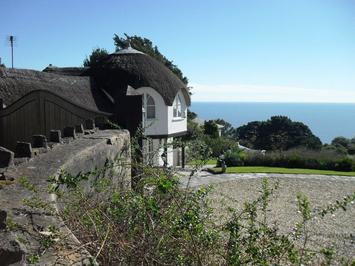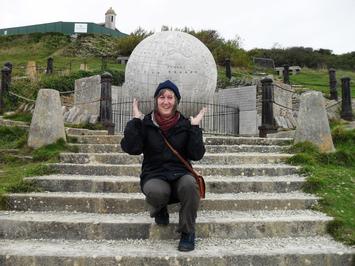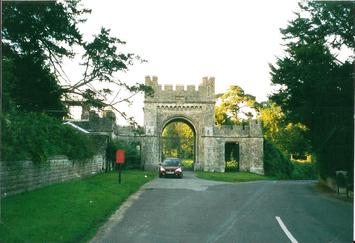ATHELHAMPTON SY 770 942

Arch
Date taken: 11/08/2007
Date taken: 11/08/2007
ATHELHAMPTON SY 770 942

Dovecote
The dovecote at Athelhampton dates back to the early 16th century and has about 600 pigeon-holes. It is 25 feet high and 22 feet in diameter.
Date taken: 11/08/2007
The dovecote at Athelhampton dates back to the early 16th century and has about 600 pigeon-holes. It is 25 feet high and 22 feet in diameter.
Date taken: 11/08/2007
ATHELHAMPTON SY 770 941

Pavilions
Francis Inigo Thomas designed two pavilions and the South Terrace at Athelhampton for Alfred Cart de Lafontaine in the 1890s. One, with a smiling face over the door, is called the House of Joy or the House of Summer, and the other is known as the House of Sorrow or the House of Winter and has a face surrounded with icicles.
The Pavilions originally had water tanks to supply the fountain.
Francis Inigo Thomas also designed two pavilions at HICKLETON, West Riding.
Francis Inigo Thomas designed two pavilions and the South Terrace at Athelhampton for Alfred Cart de Lafontaine in the 1890s. One, with a smiling face over the door, is called the House of Joy or the House of Summer, and the other is known as the House of Sorrow or the House of Winter and has a face surrounded with icicles.
The Pavilions originally had water tanks to supply the fountain.
Francis Inigo Thomas also designed two pavilions at HICKLETON, West Riding.
CASTLETON
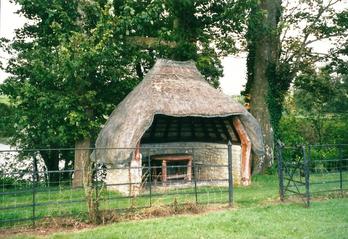
Sherborne Castle Thatched Picnic House
CASTLETON ST 648 164

Sherborne Castle Orangery
The Orangery was built between 1779 and 1781 and was known as the Greenhouse.
The Orangery was built between 1779 and 1781 and was known as the Greenhouse.
CASTLETON ST 648 164

Sherborne Castle Game Larder
Date taken: 17/08/2014
Date taken: 17/08/2014
CASTLETON ST 648 164

Sherborne Castle Ice House
The ice house was built in 1780 by Henry Plackett to replace the one built in 1757.
Date taken: 17/08/2014
The ice house was built in 1780 by Henry Plackett to replace the one built in 1757.
Date taken: 17/08/2014
CASTLETON ST 648 164

Sherborne Castle Dairy
The Gothick style dairy was built in 1756, and still has stone thrawls.
The 4th century Roman mosaic pavement was discovered in 1834 at Leathray Common, on the outskirts of Sherborne, and then reset in the dairy floor in 1836. It depicts Apollo playing a lyre and Marsyas playing a double flute.
The Gothick style dairy was built in 1756, and still has stone thrawls.
The 4th century Roman mosaic pavement was discovered in 1834 at Leathray Common, on the outskirts of Sherborne, and then reset in the dairy floor in 1836. It depicts Apollo playing a lyre and Marsyas playing a double flute.
CASTLETON

Raleigh's Seat
Walter Raleigh acquired Sherborne Old Castle in 1592 and built Sherborne Lodge nearby. Raleigh's Seat was built on the perimeter wall as a viewing platform, and tradition has it that it is where he was drenched with water by a servant to extinguish his pipe.
Date taken: 17/08/2014
Walter Raleigh acquired Sherborne Old Castle in 1592 and built Sherborne Lodge nearby. Raleigh's Seat was built on the perimeter wall as a viewing platform, and tradition has it that it is where he was drenched with water by a servant to extinguish his pipe.
Date taken: 17/08/2014
CASTLETON
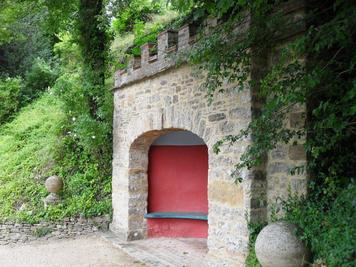
Pope's Seat
Alexander Pope, a friend of owner Robert Digby, visited Sherborne Castle in 1724 and wrote a description of the gardens mentioning a 'rustic Seat of stone'.
It is thought that Henry Holland designed the present alcove in 1778, and it became known as Pope's Seat.
Date taken: 17/08/2014
Alexander Pope, a friend of owner Robert Digby, visited Sherborne Castle in 1724 and wrote a description of the gardens mentioning a 'rustic Seat of stone'.
It is thought that Henry Holland designed the present alcove in 1778, and it became known as Pope's Seat.
Date taken: 17/08/2014
CASTLETON ST 648 167

Sham Wall
In the estate accounts for 1755 there is an entry of £10 6s 6d for a stone wall.
Date taken:17/08/2014
In the estate accounts for 1755 there is an entry of £10 6s 6d for a stone wall.
Date taken:17/08/2014
GODMANSTONE SY 667 973

The Smith's Arms
The Smith's Arms, said to be the smallest pub in England, was originally a blacksmith's forge dating back to the 15th century. King Charles II stopped here to have his horse shod, but when he asked for a drink, the blacksmith replied, 'I have no license sir'. So the king granted him one.
The Smith's Arms, said to be the smallest pub in England, was originally a blacksmith's forge dating back to the 15th century. King Charles II stopped here to have his horse shod, but when he asked for a drink, the blacksmith replied, 'I have no license sir'. So the king granted him one.
HORTON SU 030 067

Sturt's Folly
The 140 feet high tower at Horton was built by Humphrey Sturt about 1722. He probably intended it to be an observatory and hunting stand.
In 1762 Edward Gibbon visited Sturt's estate and wrote;
an artificial piece of water of two hundred acres and an elegant turret 140 feet high; but such a nature is the man that he keeps his place in no order, sells his fish, and makes a granary of his turret.
Date taken: 17/08/2014
The 140 feet high tower at Horton was built by Humphrey Sturt about 1722. He probably intended it to be an observatory and hunting stand.
In 1762 Edward Gibbon visited Sturt's estate and wrote;
an artificial piece of water of two hundred acres and an elegant turret 140 feet high; but such a nature is the man that he keeps his place in no order, sells his fish, and makes a granary of his turret.
Date taken: 17/08/2014
KIMMERIDGE SY 908 786

Clavell Tower
The tower was built in 1820 by Rev John Richards, who inherited the Smedmore Estate and added Clavell to his name.
The photograph shows the tower almost falling into the sea, but it has now been moved further inland and is a Landmark Trust holiday let.
The tower was built in 1820 by Rev John Richards, who inherited the Smedmore Estate and added Clavell to his name.
The photograph shows the tower almost falling into the sea, but it has now been moved further inland and is a Landmark Trust holiday let.
LYME REGIS SY 334 919

Umbrella Cottage
Also known as the Mushroom Cottage, the early 19th century 'cottage orne' was once a gardener's cottage.
There is another Mushroom Cottage at Hornsea, East Riding.
Also known as the Mushroom Cottage, the early 19th century 'cottage orne' was once a gardener's cottage.
There is another Mushroom Cottage at Hornsea, East Riding.
MAPPERTON SY 503 997

Orangery
The neo-classical orangery at the Italianate Mapperton Gardens was built for Victor Montagu in 1970.
The neo-classical orangery at the Italianate Mapperton Gardens was built for Victor Montagu in 1970.
MAPPERTON SY 503 997

Croquet Pavilion
MAPPERTON SY 503 997

Summerhouse
OSMINGTON
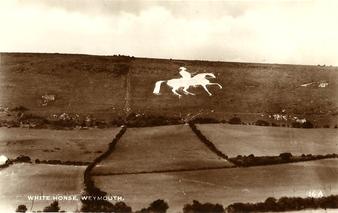
White Horse
The hill figure was cut into the chalk of Osmington Hill in 1808 and is 280 feet long and 323 feet high. It is said to represent King George III who visited Weymouth on his horse, however he may have been annoyed as the rider is facing away from the town.
It was re-cut in 2012 for the Olympics.
The hill figure was cut into the chalk of Osmington Hill in 1808 and is 280 feet long and 323 feet high. It is said to represent King George III who visited Weymouth on his horse, however he may have been annoyed as the rider is facing away from the town.
It was re-cut in 2012 for the Olympics.
PAMPHILL ST 977 011

Egyptian Obelisk
The Egyptian Obelisk at Kingston Lacy was first erected about 150BC by priests on the island of Philae to record their exemption from taxes. Its base was inscribed with the names, in Greek, of PTOLEMY VII and his sister CLEOPATRA, and the obelisk was decorated with the names of kings and gods. The Philae Obelisk played a role, along with the Rosetta Stone, in deciphering the hieroglyphs.
It was discovered by William John Bankes in 1815 and he took it to his estate at Kingston Lacy in 1821, and erected it in 1839.
The Egyptian Obelisk at Kingston Lacy was first erected about 150BC by priests on the island of Philae to record their exemption from taxes. Its base was inscribed with the names, in Greek, of PTOLEMY VII and his sister CLEOPATRA, and the obelisk was decorated with the names of kings and gods. The Philae Obelisk played a role, along with the Rosetta Stone, in deciphering the hieroglyphs.
It was discovered by William John Bankes in 1815 and he took it to his estate at Kingston Lacy in 1821, and erected it in 1839.
PAMPHILL ST 978 010
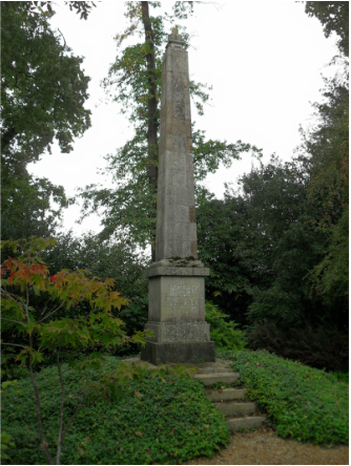
Jubilee Obelisk
The obelisk, dated 1887, commemorating Queen Victoria's jubilee is one of the three obelisks at Kingston Lacy.
Date taken: 03/10/2010
The obelisk, dated 1887, commemorating Queen Victoria's jubilee is one of the three obelisks at Kingston Lacy.
Date taken: 03/10/2010
PAMPHILL ST 976 010

Obelisk
The obelisk at Kingston Lacy near the ha-ha has no inscription and is probably 18th century.
Date taken: 03/10/2010
The obelisk at Kingston Lacy near the ha-ha has no inscription and is probably 18th century.
Date taken: 03/10/2010
PORTESHAM SY 613 876

Hardy's Monument
The 70 feet high monument to Admiral Hardy was designed by A.D.Troyte and built in 1844. Perhaps the public subscribers were disappointed by its factory chimney-like appearance, but it does have a spiral staircase and the views from the top are stunning. It commemorates, 'Admiral Sir Thomas Hardy Bart, CCB, Flag Captain to Lord Nelson on HMS Victory at the Battle of Trafalgar'.
The 70 feet high monument to Admiral Hardy was designed by A.D.Troyte and built in 1844. Perhaps the public subscribers were disappointed by its factory chimney-like appearance, but it does have a spiral staircase and the views from the top are stunning. It commemorates, 'Admiral Sir Thomas Hardy Bart, CCB, Flag Captain to Lord Nelson on HMS Victory at the Battle of Trafalgar'.
SHAFTSBURY
STEEPLE SY 912 817

Grange Arch
Dennis Bond, of Creech Grange, had an eyecatcher built in about 1746 to be seen from his house.
The Bond family must have had an eye for fashion, as they had developed Bond Street in 1684.
Other eyecatcher arches can be seen at;
STEEPLE ASTON, Oxfordshire
'Hundy Mundy', NEWTHORN, Borders
Dennis Bond, of Creech Grange, had an eyecatcher built in about 1746 to be seen from his house.
The Bond family must have had an eye for fashion, as they had developed Bond Street in 1684.
Other eyecatcher arches can be seen at;
STEEPLE ASTON, Oxfordshire
'Hundy Mundy', NEWTHORN, Borders
SWANAGE SZ 037 786
|
Wellington Clock Tower
The tower was designed in the Perpendicular style by Arthur Ashpital and built in 1854 at the southern approach to London Bridge as a memorial to the Duke of Wellington. It became an obstruction to traffic and re-erected, minus the clock, on its present site in 1867 by Thomas Dowca who had been given it by his friend, George Burt. It is thought that the owner in 1904 was offended that a secular building should have an ecclesiastical style so the spire was replaced by a cupola. |
SWANAGE SZ 033 772

Durlston Head Castle
Durlston Head Castle was built for George Burt in 1887 as a restaurant for a holiday complex.
It has recently undergone extensive restoration and is now a restaurant once more.
Durlston Head Castle was built for George Burt in 1887 as a restaurant for a holiday complex.
It has recently undergone extensive restoration and is now a restaurant once more.
SWANAGE

The Globe
The large Globe is one of many follies that George Burt made in the late 19th century. It weighs 40 tons and is 10 feet in diameter.
Date taken: 07/10/2010
The large Globe is one of many follies that George Burt made in the late 19th century. It weighs 40 tons and is 10 feet in diameter.
Date taken: 07/10/2010
TOLPUDDLE

Sculpture
The sculpture is of George Loveless awaiting transportation to Australia to join the other five Tolpuddle Martyrs but too sick to travel.
Date taken: 08/10/2010
The sculpture is of George Loveless awaiting transportation to Australia to join the other five Tolpuddle Martyrs but too sick to travel.
Date taken: 08/10/2010
UPWEY SY 660 851

The Wishing Well
In 1212 the parish was known as Helewell, which meant 'healing well'.
King George took the waters there.
The wellhead, the springhead of the River Wey, was built in the 19th century and was rebuilt in 1991.
In 1212 the parish was known as Helewell, which meant 'healing well'.
King George took the waters there.
The wellhead, the springhead of the River Wey, was built in the 19th century and was rebuilt in 1991.




















